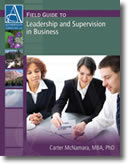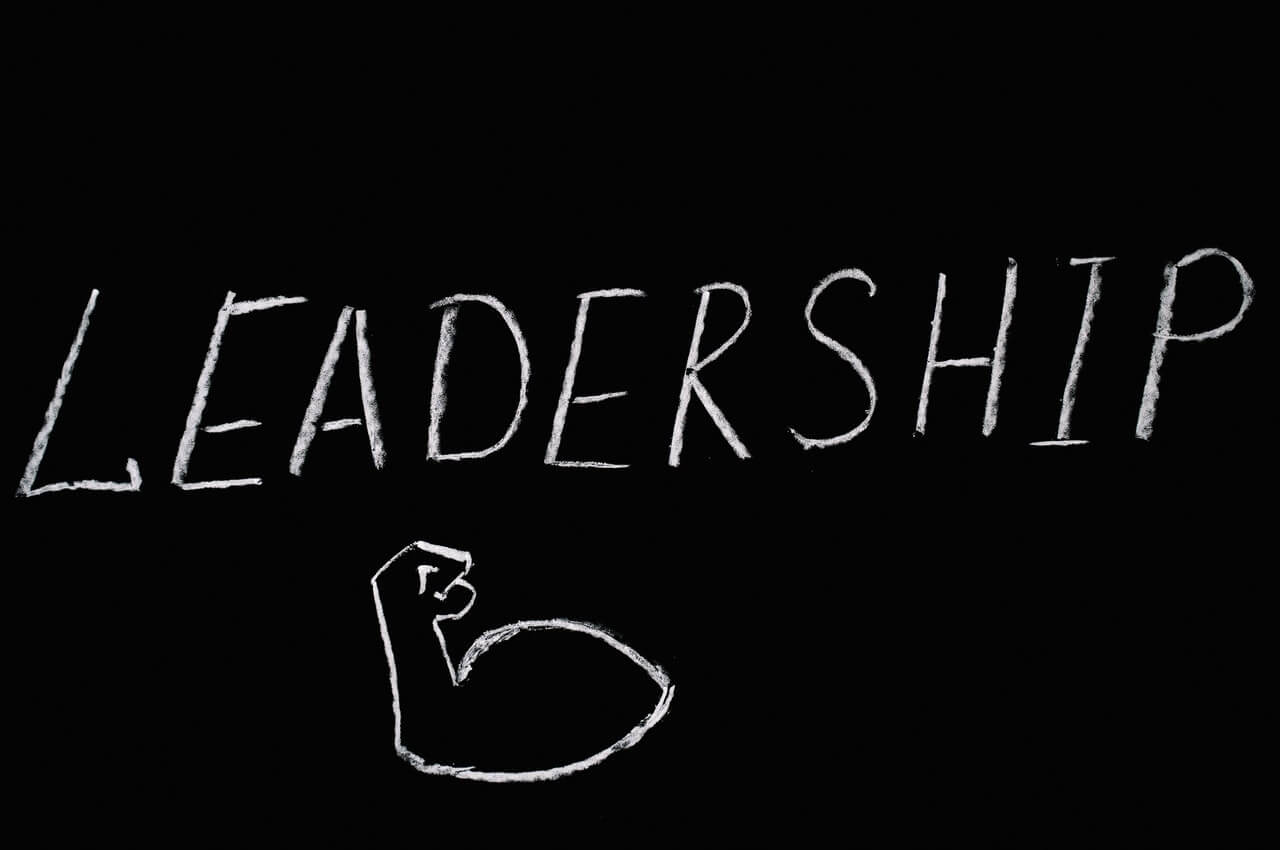How to Design Your Management Training and Development Program
Written by Carter McNamara, MBA, PhD, Authenticity Consulting, LLC. Copyright; Authenticity Consulting, LLC
(Note that there are separate topics about How to Design Your Leadership Development Program and How to Design Your Supervisor Development Program. Those two topics are very similar to this topic about management development, but with a different focus.)
Sections of This Topic Include:
- Prepare for Your Learning and Development
— Be Sure You Know What Learning and Development Really Are
— Consider Two Different Approaches to Learning About Management
— Know How to Capture Learning from Your Activities - Prepare for Learning About Management
— Get Acquainted With Organizational Context of Management
— Get Acquainted With What “Management” Is - Activities for Informal Approach to Management Development
- Guidelines for Formal Approach to Management Development
— Identify Your Overall Goals for Program
— Determine Your Learning Objectives and Activities to Achieve Them
— Develop Any Materials You May Need
— Plan Implementation of Your Program
— Evaluate During and After Your Program
— Follow-Up After Completion of Your Program - Free Basic Guide to Leadership and Supervision
Prepare for Your Learning and Development
Be Sure You Know What Learning and Development Really Are
Most of us are so conditioned from many years in schooling that we think of learning and development as coming from a program in which our participation is graded by experts in a certain topic. As a result, many of us still miss numerous opportunities for our own learning and development. Perhaps one of
the reasons is that we do not know what learning and development really is. So before undertaking a management development program, we should be sure that we know what we are talking about.
Learning could be interpreted as new:
- Knowledge, which is information that is useful in accomplishing a certain activity that is important, for example, to solve a problem, achieve a goal or see a situation in entirely different light.
- Skills, which is the expertise — consciously or unconsciously — to continually use the new information to accomplish that certain activity. (Educators often refer to new abilities as a component of learning, but some admit that the difference between abilities and skills is such a fine one that it is often difficult to explain.)
- Perceptions, which are new ways of seeing a situation. (When people are continually stuck when trying to solve a problem or achieve a goal, it is often in the way that they see the situation.)
In the field of education, development could be interpreted as the activities to raise the quality of performance, for example, of a person, team or organization. However, like learning, development is best accomplished if it is recognized as such. Thus, development usually requires ongoing focus and attention to the quality of performance, as well as the quality of the activities to raise it.
Consider Two Different Approaches to Learning About Management
It is important to understand the different approaches you can take in increasing your learning about management. Formal approaches are proactively designed in a comprehensive and systematic way in order to accomplish certain desired outcomes. Traditional classroom approaches to education have that specific form — they are formal approaches to learning and development.
In contrast, informal approaches are those that occur during our typical day-to-day activities in life and can include, for example, reading books, having discussions with friends, on-the-job training and keeping a diary with thoughts about management.
Know How to Capture Learning from Your Activities
Whether in formal or informal approaches, the ongoing ability to recognize and capture learning is extremely important. That ability is often referred to as continuous learning and it is frequently mentioned in literature about management development (in this context, the term management is inclusive of leadership and supervisor development). Simply put, continuous learning is the ability to learn to learn.
The key to cultivating continuous learning is the ability to continually reflect on your experiences and the experiences of others in your life. Reflection is continuously thinking about, for example, your experiences, their causes and effects, your role in them, if they changed you and how. It is thinking about how you might use those experiences and changes to enhance your life and the lives of others.
If you can view your life as a “laboratory for learning program”, then you can continue to learn from almost everything in your life. However, learning is best captured if it is consciously recognized as such, for example, discussed with someone else or written down somewhere. Otherwise, new learning can easily be lost in the demands of life and work. So it is very important to document your learning.
Prepare for Your Learning About Management
Get Acquainted With Organizational Context of Management
Before learning more about management, you would benefit first from becoming acquainted with the organizational context in which management typically occurs, including understanding organizations as systems, their common dimensions, what makes each unique, their different life cycles and different cultures.
Get Acquainted With What “Management” Is
Then, the next place to start learning about management is to get some sense of what management really is — in particular, get an impression of the areas of knowledge and skills recommended for effective management in organizations. Review the information in the Library’s topic:
Activities for Informal Approach to Management Development
Here is but a sampling of the activities from which you could informally accomplish your own management development. Here is a sample learning journal that you might use to continually capture your learning.
Consider getting assistance
Consider these readings Consider practicing these management skills Consider workplace activities for learning
Close and gaps in your work performance
|
Close any growth or opportunity gaps
Assess your management skills Assess management practices in: Collect ideas from others
Reference lists of suggested competencies
Reference publications about management
Consider other sources for learning
|
Guidelines for Formal Approach to Management Development
You are much more likely to develop skills in management from participating in a formal program approach than an informal approach. The following sections will guide you to develop your own complete, highly integrated and performance-oriented program.
Identify Your Overall Goals for Your Program
This section helps you identify what you want to be able to do as a result of implementing your program, for example, to qualify for a certain job, overcome a performance problem or achieve a goal in your career development plan. You are often better off to work towards at most two to four goals at a time, rather than many. There are a variety of ways to identify your program goals, depending on what you want to be able to accomplish from the program. The articles might be helpful in preparing you to identify your goals.
Various Ideas for Management Development Goals
- Do you have career plans that would require certain new management skills? See How to Plan Your Career.
- Did your previous performance review with your supervisor suggest certain improvements in management that you need to make? See Goal Setting With Employees.
- Are there certain opportunities that you could take advantage of if you soon developed certain new management skills? See How to Look for a Job.
- You might do some self-assessments to determine if there are any areas of management development that you might undertake. See Assessing Your Training Needs.
- Ask others for feedback about your management skills. See Giving and Receiving Feedback.
- Do you find yourself daydreaming about doing certain kinds of activities? See Setting Personal Goals.
Include a Goal About Managing Yourself
You cannot effectively manage others unless you first can effectively manage yourself. Consider goals from the Library’s topic of Personal Wellness
List your Program Goals in your Template for Planning Your Professional Development Program. (This is a Microsoft Word document.)
Determine Your Learning Objectives and Activities to Achieve Each
The purpose of this section is to help you to identify the various learning objectives you should achieve in order to achieve your overall program goals, along with the activities you should undertake to achieve each objective.
Identifying Your Learning Objectives
Carefully consider each of your program goals. What might be the various accomplishments, or objectives, that must be reached in order to achieve each goal? Do not worry about doing all of that perfectly — objectives can be modified as you work to achieve each goal. Which of these objectives require learning new areas of knowledge or skills? These objectives are likely to become learning objectives in your program plan. To get a stronger sense for learning objectives, see
Identifying Your Learning Activities
Learning activities are the activities you will conduct in order to achieve the learning objectives. The activities should accommodate your particular learning styles, be accessible to you and be enjoyable as well. The long list of activities in the above two columns might be useful, as well.
List the Learning Objectives to Achieve Each Desired Goal in your Template for Planning Your Professional Development Program.
List the Activities to Achieve Each Learning Objective in your Template for Planning Your Professional Development Program.
Develop Any Materials You May Need
Carefully think about each of the activities to achieve the learning objectives. Consider, for example, getting books, signing up for courses, reserving rooms and getting trainers.
List the Materials You Might Need in your Template for Planning Your Professional Development Program.
Plan the Implementation of Your Program
During the implementation of your program, you want to make sure there are no surprises. For example, how will you make sure you understand the new information and materials. Will your learning be engaging and enjoyable? Will you have all the support you need?
List the Key Considerations in Implementing Your Plan in your Template for Planning Your Professional Development Program.
Evaluate During and After Your Program
Evaluation includes assessing both the quality of the activities during the program and also whether you achieved your goals soon after the program.
List the Approach to Evaluating During and After Your Program in your Template for Planning Your Professional Development Program.
Follow-Up After Completion of Your Program
It is a major accomplishment to design and implement a management development program. Celebrate what you have done! Reflect on what you learned about developing the program — and about yourself.
List the Key Activities After Completing Program in your Template for Planning Your Professional Development Program.
Additional Resources in the Category of Leadership















